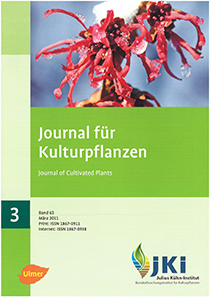Viruses in winter barley – is the production of this crop in Germany threatened by another soil-borne virus?
DOI:
https://doi.org/10.5073/JfK.2011.03.04Keywords:
Cereal viruses, soil-borne viruses, furovirus, Soil-borne cereal mosaic virus, Soil-borne wheat mosaic virus, barleyAbstract
The production of winter barley in Germany is threatened by a number of insect- and fungus- transmitted viruses. The situation is now worsened by the discovery of a new soil-borne virus. It was isolated from barley varieties possessing resistance to viruses of the barley yellow mosaic disease complex. The new virus has two sizes of rod-shaped virions that measure about 180 nm and 300 nm in length and 20 nm in diameter and can be decorated by immunogold labeling using selected furovirus-specific antibodies. Based on results of serological tests and preliminary molecular analysis, the new barley virus was closely related to isolates of Soil-borne cereal mosaic virus or Soil-borne wheat mosaic virus, two viruses hitherto only isolated in Germany from rye, triticale and winter wheat but never from winter barley. Further investigations will focus on the geographic distribution and relative importance of the new furovirus in Germany and on its identity to similar furoviruses isolated from barley in France and Japan.
Downloads
Published
Issue
Section
License
The content of the journal is licensed under the Creative Commons Attribution 4.0 License. Any user is free to share and adapt (remix, transform, build upon) the content as long as the original publication is attributed (authors, title, year, journal, issue, pages).
The copyright of the published work remains with the authors. The authors grant the Journal of Cultivated Plants, the Julius Kühn-Institut and the OpenAgrar repository the non-exclusive right to distribute and exploit the work.







